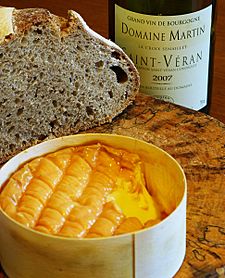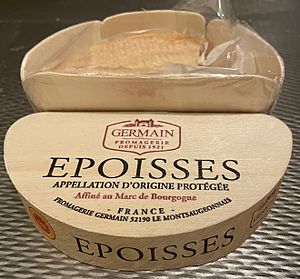Époisses facts for kids
Quick facts for kids Époisses |
|
|---|---|
 |
|
| Country of origin | France |
| Region, town | Côte-d'Or, Époisses |
| Source of milk | Cows |
| Pasteurized | Some |
| Texture | Soft, washed rind |
| Aging time | At least six weeks |
| Certification | French AOC 1991 |
Époisses, also known as Époisses de Bourgogne, is a special cheese from France. It is made in the village of Époisses and nearby areas. This village is in the Côte-d'Or region, which is about halfway between Dijon and Auxerre. The cheese is made using traditional methods and resources from this area.
Époisses is a soft cheese with a strong smell. It is made from cow's milk. Its rind is "washed" with salty water and a local brandy called Marc de Bourgogne. This washing gives it a special red-orange color. The cheese is round, about 10 or 18 centimeters (4 or 7 inches) wide. It can be made from raw or pasteurized milk. Époisses is often sold in a round wooden box. Because it is so soft, it is sometimes served with a spoon in restaurants. People often enjoy this cheese with Trappist beer or even a sweet wine like Sauternes.
The Story of Époisses Cheese
The story of Époisses cheese began a long time ago. Around the 1500s, a group of monks called Cistercians lived in the village of Époisses. Legend says these monks started making the cheese.
About 200 years later, the monks left the area. Local farmers then learned the cheese recipe from them. Over the next century, the cheese became very popular. Even famous people loved it. Napoleon was a big fan of Époisses. A well-known food expert, Jean Anthelme Brillat-Savarin, even called it the "king of all cheeses."
By the early 1900s, over 300 farms were making Époisses. But after World War II, almost no one was making it anymore. Many men went to war and did not return. This meant women had to work in the fields. Because of this, local dairy farms and cheese-making were often forgotten.
In 1956, a farming couple named Robert and Simone Berthaut decided to bring Époisses back. They worked with people who still knew how to make the cheese the old way. Their company, Fromagerie Berthaut, became very successful. Today, their son, Jean Berthaut, continues the business. While Berthaut makes a lot of Époisses, some smaller, artisan cheese makers also produce it.
How Époisses Cheese is Made

Making Époisses cheese involves several careful steps. First, the whole milk is heated to about 30 degrees Celsius (86 degrees Fahrenheit). It then sits for at least 16 hours to thicken. This creates soft curds.
Next, the curds are put into molds to drain. The liquid, called whey, runs off. About two days later, the cheese is taken out of the molds. It is then salted and placed on racks to dry. Once dry, the cheese moves to special cellars to age.
Each cheese is rinsed up to three times a week. This rinse is a mix of water and marc, a local brandy. The cheese is also brushed by hand. This helps spread special bacteria evenly over its surface. These bacteria, along with yeast, create the cheese's unique orange-red outside color. This aging process takes about six weeks.
In 1991, Époisses received a special status called appellation d'origine contrôlée (AOC). This means its production must follow strict rules:
- The milk must thicken naturally using lactic acid for 16 hours.
- The curds must be cut roughly, not broken into small pieces.
- After draining, only dry salt can be used.
Under AOC rules, only cheese made in certain towns in the Côte-d'Or, Haute-Marne, and Yonne regions can be called Époisses.
See also
 In Spanish: Époisses de Bourgogne para niños
In Spanish: Époisses de Bourgogne para niños


